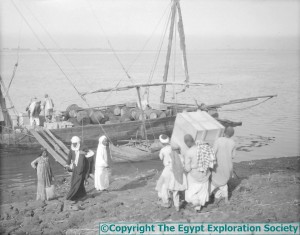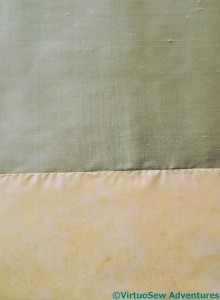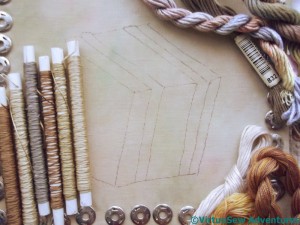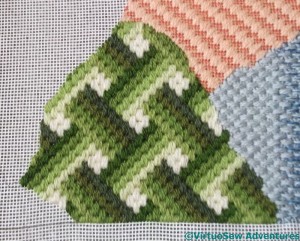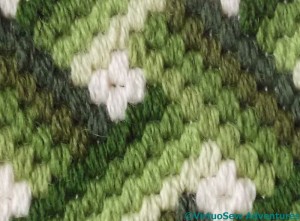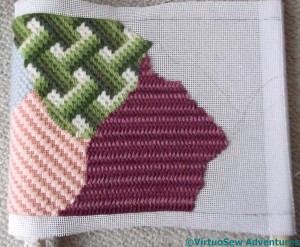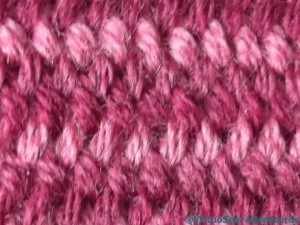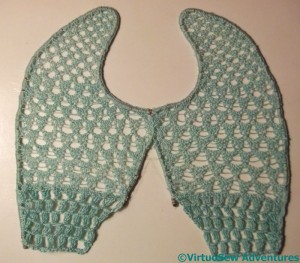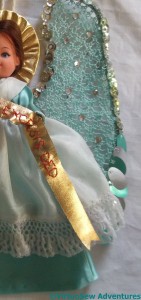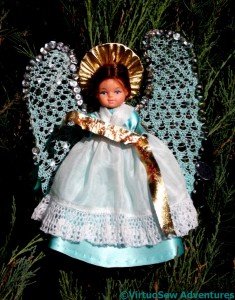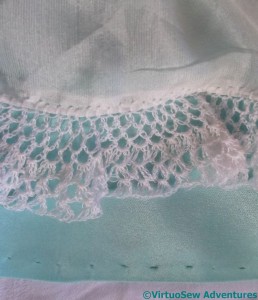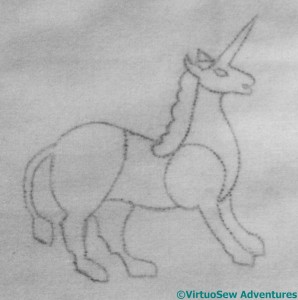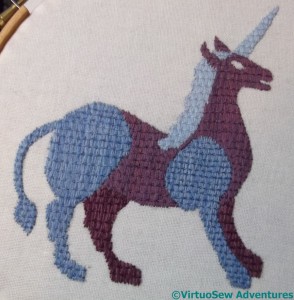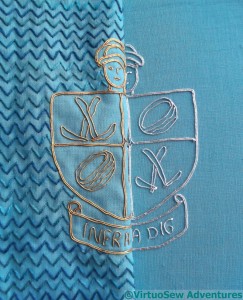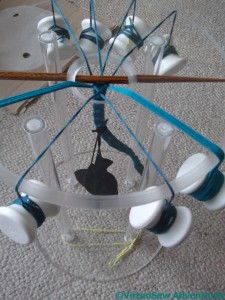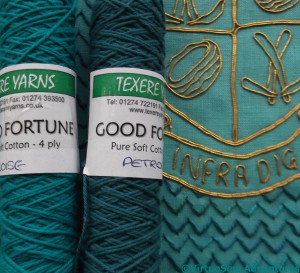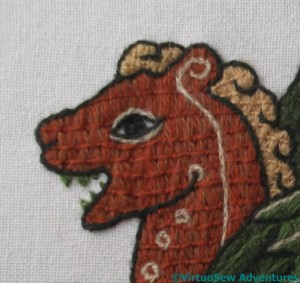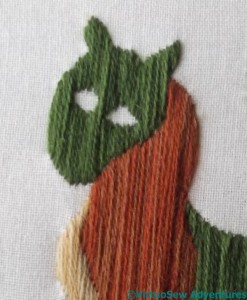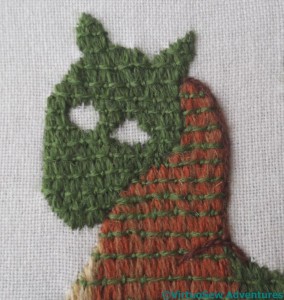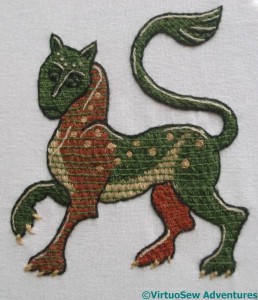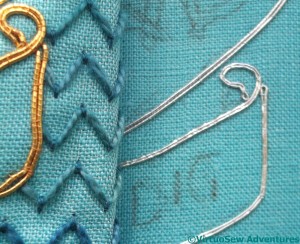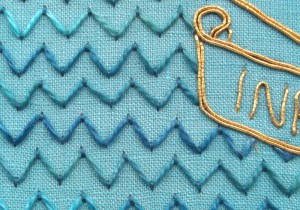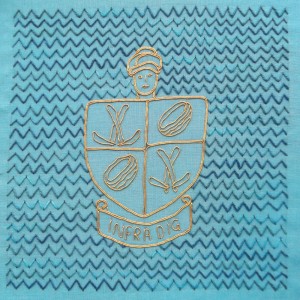About Rachel
View all posts by Rachel
Loading the Felucca
Here is another one of the photographs from the Egypt Exploration Society that I would like to represent in some way.
The expedition felucca was loaded with all the excavated finds and taken to Cairo so that the Cairo Museum Director could choose what would be retained for their collection. The carpenter spent weeks making special boxes to carry the more delicate finds, like Hatiay’s carved door lintel, and a large section of decorated wall plaster (more things for me to embroider!). Then everything had to be loaded on to the felucca…
I’ve decided to concentrate on the group carrying the packing case. Partly this is because the whole photograph is a little confusing and difficult to decipher in places, and partly because they rather drew my eye, and I want to experiment with appliqué. What I hope to do is “dress” each figure, so the folds of the fabric I use creates the folds in the garment. I have no idea whether this will work, but if I don’t try I will never know!
Last time I was at the Harrogate Show I found myself in unfamiliar territory, frequenting the patchwork stands, in search of suitable fabrics for the ground and the clothes. I’ve used a piece of silk dupion from The Silk Route for the river. It’s a pale grey-green, and I think I will have to find somewhere else to use it to pull it into the overall design properly, but it has a lovely subtle sheen that looks quite watery. I’ve attached it around the edges using strands pulled from the weft, because I have nothing else suitable. The ground is a sandy cotton, doubled because I could see the silk through the first layer, and attached using a single strand of stranded cotton from my stash.
You last saw the fabric I chose for the packing case being used as the background for the Crock of Gold Hoard. It’s a flimsy overdyed turban cotton which won’t take much stitching without reinforcement, so I’ve backed it with a layer of white cotton to give it a bit more body.
Then I had a wonderful rummage in my stash, and pulled out a selection of silk and cotton threads to play with. The tubes are Mulberry Silks threads (also last seen in the Crock of Gold Hoard), and I’ve also laid out a linen thread, two Stef Francis stranded silks, and a couple of miscellaneous threads from I-Know-Not-Where.
This should be fun!
Gabrielle, the Christmas Angel – Part Two
And now, the Finale…
“Angels need wings. I have never made big wings before, only gauzy ones, so these grew a bit like Topsy! I had, fortuitously, a ball of crochet cotton which exactly matched Gabrielle’s dress, but I had already used crochet to make the lace on the overdress. Needlelace seemed an option if I could find a suitable former to hand. Wire proved to be too thin, and the thread slipped about, so in the end I made a frame from one strand of the plastic coated wire of electric cable. Yes, I know you can buy purpose made formers but I wanted to do it now.
After drawing the shape on heavy card, and arriving at a good shape was an interesting exercise in its own right, I couched on the wire at widely spaced intervals, then covered the wire and its plastic coat in blanket stitch using my turquoise crochet cotton. Not only did this cover the wire but it provided a anchor for the needlelace itself. I used pea stitch at first then increased the number of loops in each group first to five and then to seven to add “weight” towards the lower edge. I hadn’t provided a former across that edge as I didn’t want it to be rigid, but needlelace requires just such an edge! A single thread helped a bit but a piece of applied crotchet finally did the trick.
She looked balanced, if a bit subfusc for Christmas, so I added sequins, left over from one of Rachel’s childhood projects, mainly cup-shaped but the lower ones are long ovals to suggest pinions. Again, the colours, turquoise and silver, were a perfect match. Some people have all the luck. Rachel added crystals to increase the “bling”. The halo is a cardboard former covered with cloth of gold. I used the gathered side to suggest an aura of radiating holiness and backstitched a banner “Gloria in excelsis Deo” in red on cloth of gold, too.”
We timed our photography just right, too – the last sunny day of Autumn, before the weather turned thoroughly nasty on us…
Outside, hanging from a fir branch in the garden, Gabrielle made a remarkably effective member of the heavenly choir.
Gabrielle, the Christmas Angel – Part One
Lest you imagine my talent for complex projects sprang out of nowhere, I have asked my mother to write a couple of guest posts about one of hers – Gabrielle, the Christmas Tree Angel. Gabrielle figured on our Christmas cards this year, and she took nearly a year because she was being improvised as she went along.
—
“Looking at my collection of crochet hooks, I decided that I needed to do something quickly if I wanted to use the smallest one before my eyesight made it too difficult. I am becoming increasingly long sighted as the years progress, and my myopic Impressionist wonderland is receding. Coincidentally, it was Christmas tide, and we had just rejuvenated Bethlehem. (Ask Rachel!) A Christmas Angel for the top of the tree seemed the next proper project.
Gabrielle herself is one of Rachel’s dolls, rediscovered when we were tidying the loft. She is just the right size for our Christmas tree. A rummage through my stash of cloth provided enough satin, a beautiful turquoise, and a square of fine silk which had been the Virgin’s veil when we made a crib one year using Rachel’s dolls as the cast.
To make the dress I cut out a cross shape wide at the top and bottom narrowing towards the crossing place out of the turquoise satin. The cross piece itself, which formed the sleeves, was short and narrow. I hemmed the cuffs and a small opening for her head before folding bottom to top and sewing the side seams.
Next I tackled the silk over-dress. A line of open blanket stitch along the selvedge gave me a base for the crochet work I so wanted to do. Again, I used ordinary sewing thread and kept the design simple. It was surprisingly easy to work. In no time I had a sizeable length of delicate lace.
The original intention had been to make a cottar such as altar boys used to wear, but the very small size and filmy silk made my stitching look crude. Instead I used two pieces of folded silk over the shoulders fastened lightly to the satin and covered the raw ends with the very gathered edge of my lace bordered silk. It looks more like a pinny, but billowing satin displays the lace beautifully.”
More Laid and Couched work – The Unicorn
I enjoyed working Rusty and Spots in the Opus Anglicanum Stitchalong so much I decided I wanted to do some more laid and couched work.
I rummaged around in my heraldry books and online for medieval unicorns (for a quadruped) and swans (for something winged), and produced something of a synthesis. Some of the medieval unicorns had leopard feet, and one of them had a curly, piggy tail. Mine has vaguely leopardly feet, and a lion’s tail. I’ve sized him so that he fills the same space as did Spots.
It occurred to me that I may want to work medieval creatures in the corners of the Vision of Placidus, when I get that far. I was going to use Rusty, Spots, and their friends, but then I realised that in that context, it would be more appropriate to the story of conversion to use the symbols of the Evangelists – the winged ox, ram, man, and eagle.
So I’m still not sure what I will do with these present creatures when they are done..
Since I am using existing stores here, and I wasn’t sure I would have enough of the colours I used for Rusty and Spots, I moved on to a different colour range – purples and blues. These aren’t the slightly fluffy Appleons wools I used for the other two, but are rather smoother, softer version.
Again, I’m stretching out the colours by threading two colours in the needle for the underlayer. And my goodness, doesn’t it grow quickly!
The Second Crest for the Dig
Last month, I had made several unsatisfactory trials with silver thread, and took my headaches to the Harrogate Knitting and Stitching Show to ask advice on the Golden Hinde stand.
I got to the show with about 40 minutes to go of the Thursday evening late opening, which meant that the aisles were relatively clear and I could actually talk to Sarah. After some discussion, we came up with a very bright and blingy silver Jap. In fact it’s so bright and blingy as to be verging on mirrored, and I was surprised at quite how calm it looked when I finished it.
The reason it is so bright is that the metallic wrapping film is much broader than it was on any of the other silver threads I tried. That carries its’ own penalty, because turning corners becomes trickier – and indeed, in a few cases, rather untidier (click on the picture to enlarge it and look at a few of the corners!). I found that I had to devise new pathways for the couching, and use more short lengths. This panel is markedly more fluffy on the back than the gold one was!
I just have miles of that cloud filling stitch variation to do now (and, of course, choose and apply the braided edging!). The background stitching will help to throw the silver crest into relief. I have laid the completed gold over the silver so that you can see. With decent lighting, it should have enough personality to hold its corner.
If it doesn’t, I will frame it up as a separate panel, and show people just how difficult it was!
Experiments with A Marudai
I’ve been fascinated by Kumihimo braiding for ages. I first heard about it many years ago from a mathematician friend of my husband’s. Quite why, I can’t now recall, unless it was a desperate attempt on the part of the mathematician to find something textile-related to talk to me about.
Jolly decent of him, don’t you think? He certainly had no idea what he was starting..
Anyway, I’ve heard a lot about it, and rather like the effects that can be obtained. In the UK, the best source for information and equipment is Jacquie Carey at The Carey Company. Jacquie has also become better known to historical embroiderers because while she was researching historical braids she became fascinated by the stitches in them, and besides her books on Braiding, she has now written books about Elizabethan Stitches (remember my experiments with some of them for the Glittering Nightcap?), and Sweet Bags!
I’ve bought myself an acrylic marudai and bobbins, and spent a fascinating – not to say, bewildering! – couple of hours at Texere Yarns in Bradford, trying to find some suitable yarns to experiment with.
Since my initial aim is to create a braid edging for the Crest for the Dig, I began by finding some cotton knitting yarns that seem to go very nicely with the panels, as well as a whole load of extra yarns for additional experiments.
Then I started playing…!
Spots The Eeyoropard
Under Rusty’s very bright and beady eye, I got started on the companion that Tanya provided for him in the Stitchalong on her blog, Opus Anglicanum.
Which turned out to be a Leopard!
This closeup of his head and neck gives you a chance to see the two different shades used side by side in the underlayer of the laid and couched work.
Once I’d finished the couching – in a modern twist, Tanya suggested working all the couching in a single colour, so that the Dragon and the Leopard will offer two versions of the same stitch – I had a slight false start with the outlining. When I tried the dark chestnut red, I wasn’t entirely happy with it. I’m not sure quite why, but perhaps it simply wasn’t distinctive enough against the orangey-red.
I went back to the dark green I used on Rusty, and used the same creamy yellow for the highlights. I don’t think I put in quite the same highlight twiddles as Tanya put on hers, but I like him just the way he is.
Apparently the Leopard of the medieval bestiary is a gentle creature – in spite of the fearsome claws, and according to Tanya, they all look “terminally grumpy”. I was talking about this with my friend @Matheknitician a week or so back when she accosted me at the MathsJam weekend, saying she was desperate to know what I was going to do with Rusty, and a day later she sent me a message suggesting that we should call Spots an Eeyoropard.
So, ladies and gentlemen, – Spots the Eeyoropard! Please be nice to him – he’s rather shy..
A Dilemma
Now, you may recall from when I began the first one that there are to be two Crests, one for each panel, balancing each other. Furthermore, since there will be a gauze overlay, everything has to have the visual strength to show through it.
I don’t think that this silver thread has enough force or shine. Even with a fairly strong background using my Cloud Filling variation, to throw it into relief, it will simply disappear.
So I have been experimenting. The edge of the shield, the top of the scroll, and the bottom of the scroll, all use different threads.
All of them are equally insipid in comparison with the gold. I’m afraid that if I use any of these threads for the panel, I will end up with an unbalanced overall appearance with one corner panel seeming very faded in comparison with the other.
I hope to find a more suitable thread at the Harrogate Knitting and Stitching Show this week. Or alternatively – more of the gold so I can do a second gold one!
The First Crest for The Dig – Finished
The Cloud Filling Stitch variation that creates the ripple effect is fairly easy to do, and once I had decided to get working on it, finishing the first panel really ripped along.
As you see, I’ve not been too pernickety about spacing. It would have been possible, but it wouldn’t have been in keeping with the original inspiration, besides being utterly maddening to achieve.
I began by working each row individually, first the short stitches and then threading the pearl cotton, but I soon found that it was much quicker to do several rows of the holding stitches, and then threading the pearl cotton through them.
So here it is, done. The other crest panel, when I get to it, will be in silver, with the same background. I need to get the other piece of fabric onto the frame and get ready, because it is good to have at least one project in which I know exactly what I want to do.
There is one question that remains to be solved – how will I edge each panel? I’ve been thinking about lucetting, crochet, or kumihimo. I have a feeling that a lot of experimentation lies in my future.

